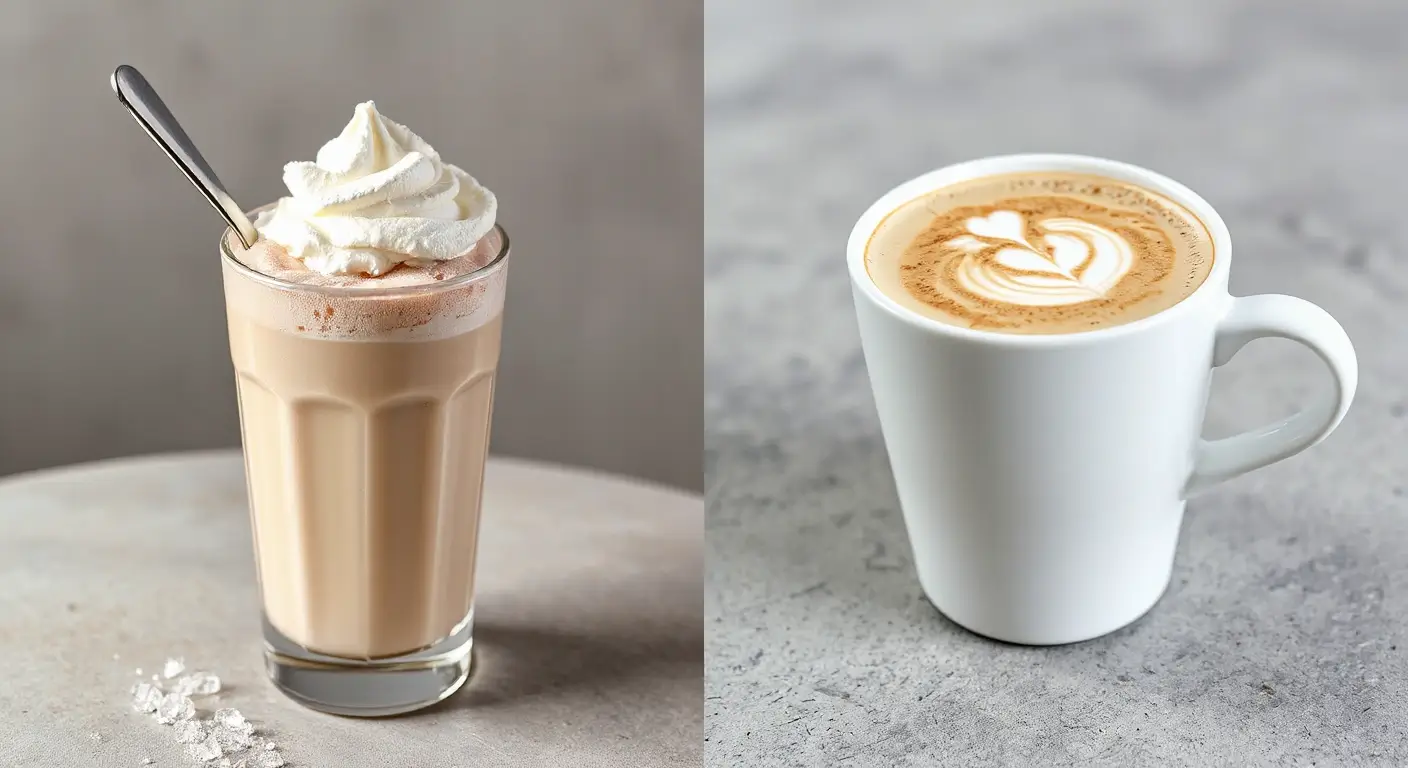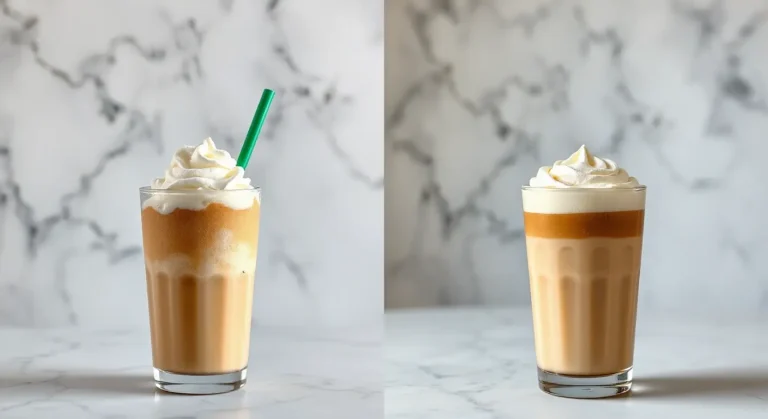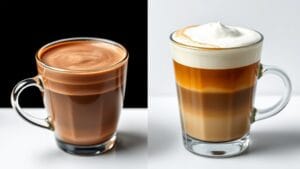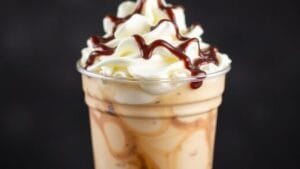As someone who spends most of my time knee-deep in coffee beans and steamed milk, I know the sheer volume of choices out there can be daunting. Two of the most common requests I hear, often uttered by someone slightly confused at the counter, involve an iced, blended treat and a comforting classic: the Frappuccino and the Cappuccino.
They sound similar, and both contain coffee and milk, but trust me, they are worlds apart. Choosing between them is less about deciding which is “better” and more about aligning your beverage choice with the immediate experience you crave. Are you looking for a dessert in a cup, or a perfectly balanced espresso ritual?
Before we dive into the delicious differences, here are the main points you need to know.
Key Takeaways
- Temperature & Texture: Frappuccinos are icy cold and blended smooth like a shake; Cappuccinos are hot and layered with liquid milk and airy foam.
- Flavor Profile: Frappuccinos are often sweet, customized with syrups and toppings, offering a dessert‑like experience. Cappuccinos emphasize the strong, slightly bitter flavor of the espresso.
- Caffeine: A standard Cappuccino typically delivers a higher concentration of caffeine per ounce due to the focused espresso shot, compared to the often diluted, ice‑heavy Frappuccino.
- The Vibe: Frappuccinos are perfect for hot days and sweet cravings; Cappuccinos are ideal for savoring warmth and the pure taste of espresso.
Understanding the Basics: Frappuccino vs Cappuccino
When you walk into a coffee shop, you are presented with a dizzying array of coffee preparations. Distinguishing between core drinks like the cappuccino vs frappuccino is the first step toward ordering exactly what you desire. These two drinks represent different ends of the coffee spectrum: one is an indulgent, modern, cold confection; the other is a timeless, traditional, hot espresso preparation. Understanding their foundational differences provides grounds for the entire comparison.

What is a Frappuccino?
A Frappuccino, which has become a globally recognized trademark of Starbucks, is essentially a brand of blended, iced coffee drink. Think of it as the ultimate coffee milkshake. It is cold, highly customizable, and distinctly different from traditional coffee beverages.
At its core, a Frappuccino is made from coffee, milk, and ice. These ingredients are blended at high speed until they achieve a uniform, slushy, and velvety smooth texture. The coffee element can be espresso, strong brewed coffee, or even a coffee base syrup.
What makes the Frappuccino so popular is its adaptability. It frequently moves beyond the basic coffee flavor, incorporating ingredients like chocolate, caramel, vanilla syrup, and sweet flavorings. Many Frappuccinos are crème‑based and contain no coffee at all, focusing instead on flavors like green tea or fruit. It’s a beverage designed for sweet tooth satisfaction and is strongly associated with iced coffee and dessert culture.
What is a Cappuccino?
The Cappuccino, on the other hand, is a cornerstone of classic Italian coffee culture. It is a hot beverage built upon a precise, rigid structure. Traditionally, a cappuccino is defined by three equal parts: one‑third espresso, one‑third steamed milk, and one‑third frothed milk (the delicate foam).
The magic of a Cappuccino lies in the layering and the texture. The rich espresso forms the base, providing a powerful aromatic kick. Above this sits the creamy steamed milk, which adds sweetness and mellows the espresso’s intensity. Capping it all is the thick, light, airy layer of milk foam (microfoam), which keeps the heat in and offers a beautiful, velvety finish to the texture.
The emphasis here is on balance and the true, unadulterated flavor of the espresso coffee beans. While some modern coffee shops offer slightly sweetened versions, a traditional Cappuccino should be a study in the harmony between strong coffee and creamy, frothy milk. This distinct preparation method is fascinating to watch. For a step‑by‑step video on how to make a classic cappuccino, including brewing espresso and steaming milk, see Methodical Coffee’s tutorial “Espresso, Milk, Foam & How We Make It at Methodical”.
Key Differences Between Frappuccino and Cappuccino
Understanding the basic composition of these two drinks only scratches the surface. The real difference between cappuccino and frappuccino surfaces when we compare their structural elements, flavor profiles, and stimulating effects. These differences dictate when and for what purpose you might choose one over the other. Examining the distinction between a frappuccino vs macchiato or a macchiato vs frappe shows how temperature and preparation define the entire experience. If you’re trying to distinguish a mocha vs frappuccino, remember that even a mocha has a warm, liquid base, unlike the blended Frappuccino.
| Characteristics | Frappuccino | Cappuccino |
|---|---|---|
| Temperature | Cold (frozen) | Hot |
| Texture | Blended, smooth, creamy | Layered, velvety, frothy |
| Flavor | Coffee, milk, and added flavorings (e.g. vanilla, chocolate) | Strong espresso, balanced with steamed milk |
| Caffeine Content | Varies (dependent on size and type of coffee used) | Moderate to high (due to espresso shot) |
Temperature and Texture
The most immediate difference is temperature. One is designed to cool you down; the other is meant to warm you up. This factor fundamentally changes the entire drinking experience.
The Frappuccino is relentlessly cold. It is served with ice, and the large amount of ice used helps create its signature texture. Because it is blended, the texture is uniform—a thick, smooth, and creamy slush that feels like drinking a frozen dessert. There are no distinct layers; every sip carries the same consistency.
The Cappuccino is traditionally hot. Its texture, unlike the Frappuccino’s uniformity, is all about the layers:
- Frappuccino is cold, while Cappuccino is hot
- Frappuccino has a smooth and icy texture due to the blending with ice, whereas Cappuccino has a layered texture with a combination of frothed milk, steamed milk, and espresso
- The cold temperature of Frappuccino gives it a thicker and more velvety texture, while Cappuccino has a more fluid texture with a distinct layering of froth, steamed milk, and espresso
- Cappuccino’s texture can also be more delicate and airy due to the frothed milk on top, whereas Frappuccino’s texture remains consistent throughout the drink.
This layered structure means the texture changes as you sip, moving from airy foam to creamy liquid and finally to the dense espresso at the bottom (if not stirred). The velvety microfoam is what many coffee aficionados look for as a marker of a well‑made drink.
Flavor Profile and Caffeine Content
When comparing flavor, we must compare highly sweetened indulgence with classic, balanced intensity. Frappuccinos lean heavily toward the sweet, dessert‑like side. The strong coffee base is often muted or entirely overwhelmed by pumps of syrup, chocolate chips, caramel drizzle, and a generous dollop of whipped cream. While they often contain coffee, the overall taste is more about the added flavorings and sweetness.
Cappuccinos, by design, focus on the inherent richness of the espresso. The flavor is robust, slightly bitter, and aromatic, softened but not masked by the steamed milk. The goal is to taste the coffee beans. This focused flavor profile means a Cappuccino offers a much stronger sensory experience of the espresso itself.
Regarding caffeine, the difference is often less about the absolute amount and more about concentration. A cup of cappuccino (about 6 oz with one espresso shot) contains roughly 63–80 mg of caffeine, a coffee‑based Starbucks Frappuccino of comparable size (Tall 12 oz) contains about 65–75 mg, so the cappuccino delivers a higher caffeine concentration and overall dose per ounce. Frappuccinos are often diluted with ice and may have lower caffeine, especially the crème‑based varieties.
Choosing Between a Frappuccino and a Cappuccino
So, how do you decide which cup to reach for? The choice between a Frappuccino and a Cappuccino is purely personal, revolving around three key factors: the weather, your craving level, and your preferred coffee intensity.
If the sun is beating down and you seek immediate refreshment, the Frappuccino is your cold, creamy friend. It satisfies the desert craving while still giving you a light jolt of caffeine (if you choose the coffee‑based version). It’s a fun, indulgent treat, perfect for when you want a highly customized drink with lots of flavor.
If you are a coffee traditionalist, value the artistry of espresso preparation, and prefer a drink served hot, the Cappuccino is the answer. It’s an ideal morning beverage or mid‑afternoon pick‑me‑up designed for sipping slowly. The Cappuccino experience is about appreciating the coffee’s flavor, the warmth of the milk, and the delicate texture of the foam. For those who prioritize the authentic taste of coffee, the Cappuccino remains superior.
When making drink decisions that involve milk, remember that taste is the primary factor influencing choices, with significant opposition to extra charges for non‑dairy options, particularly among younger consumers—something coffee shops are always addressing as noted in studies like a recent consumer preference study on Milking the Alternatives: Understanding Coffee Consumers. Always consider how factors like custom syrups or milk alternatives will alter the drink’s final temperature and texture.
When deciding between a Frappuccino and a Cappuccino, consider your preferences for temperature, texture, and flavor. If you prefer cold, sweeter drinks with a uniform texture, a Frappuccino might be the better choice. If you enjoy hot coffee drinks with a strong espresso flavor and varied textures, a Cappuccino could be more appealing.

Final Sip
The decision between a Frappuccino and a Cappuccino is a microcosm of the wider coffee culture—a choice between classic tradition and modern innovation, between heat and ice, between espresso purity and sweet customization.
In the end, neither drink is inherently “better”; they simply cater to different needs and moments. By understanding their differences in terms of ingredients, preparation, taste, and caffeine content, you are now equipped to make an informed choice that perfectly suits your taste preferences and the desired coffee experience. Whether you choose the creamy, bold simplicity of a Cappuccino or the sweet, blended bliss of a Frappuccino, may your next cup be exactly what you need.
FAQ
Q: Is a Frappuccino always made with coffee?
A: No, many Frappuccinos, often labeled as “crème-based,” contain no coffee or espresso, relying instead on flavorings and milk.
Q: Which drink is generally healthier?
A: A plain Cappuccino (without added sugar) is typically considered healthier due to its lower sugar, calorie, and fat content compared to a standard sweetened Frappuccino.
Q: Can I order an iced Cappuccino?
A: While possible in some modern shops, a traditional Cappuccino relies on hot steamed and frothed milk. Ordering an iced version often results in something closer to a latte or a shaken coffee drink, not a true Cappuccino.
Q: What is the main difference between a Frappe and a Mocha?
A: A Frappe is usually a generic term for a cold, blended iced drink (like a Frappuccino), while a Mocha is a warm, liquid drink made from espresso, steamed milk, and chocolate syrup.
Q: Is a Frappuccino thicker than a Macchiato?
A: Yes, a Frappuccino (a blended slush) is much thicker than a Macchiato, which is layered liquid espresso and steamed/foamed milk.





